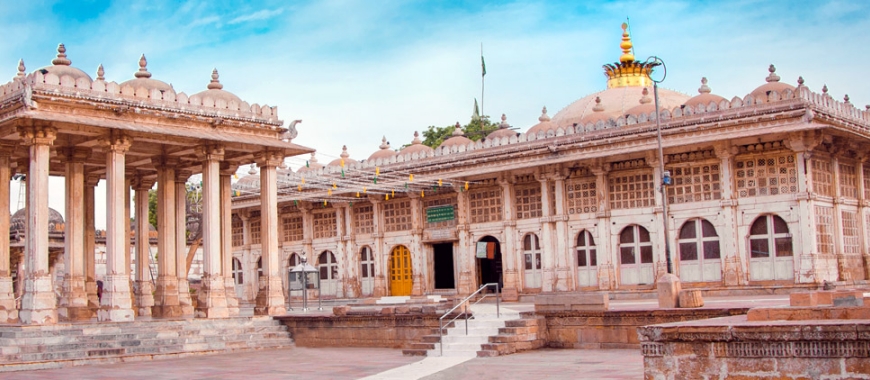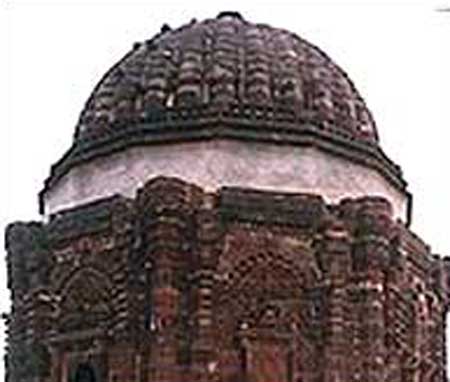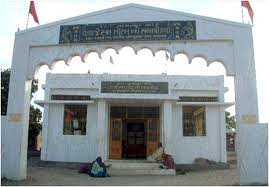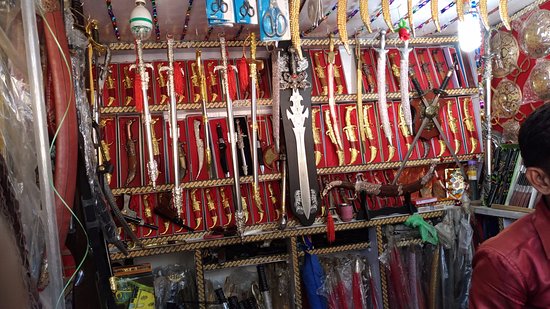Tomb of Jesal Toral
Monday, 05 October 2009 12:05
Tomb of Jesal Toral Anjar |
About: |
|
The Tomb of Jesal Toral is a revered historical and spiritual site located in Anjar, Kutch district, Gujarat, India. It is dedicated to Jesal, a bandit who turned into a saint, and Toral, a pious woman who guided him towards spirituality. Their story of transformation, love, and spirituality is popular in Gujarati folklore, making the tomb an important pilgrimage spot and a symbol of redemption and spiritual awakening. Bhuj is distinguished by its brightly decorated Hindu temples, beautiful palaces and intricately carved wooden pavilions. It is a paradise for handicraft lovers. The houses here are decorated both from inside as well as outside with linear reliefs made from mud and mirrors. Bhuj is famous for embroidery. The oldest museum of Gujarat is situated in Bhuj.  |
Location info: |
| Address:Tomb of Jesal Toral,Anjar,Kutchh,Gujrat,India |
| Location: Anjar, Kutch district, Gujarat, India |
| Nearest City: Bhuj |
| Language: Gujarati, Hindi, and local dialects like Kutchi |
| Best time to visit: November to April |
Climate/Weather: |
| Summer (March to June): Hot, with temperatures ranging from 30°C to 45°C Monsoon (July to September): Experiences moderate rainfall, with a temperature range of 25°C to 35°C Winter (October to February): Cool and pleasant, with temperatures ranging from 10°C to 25°C, making it the ideal time to visit |
History: |
| The story behind the tomb is a fascinating tale of transformation. Jesal, a notorious bandit, once attempted to steal from Toral, a saintly woman. However, her spiritual influence transformed him, and he gave up his life of crime to become a devotee and her disciple. Their journey together is celebrated in Gujarati folklore, and the tomb was constructed in Anjar as a symbol of their spiritual journey and union. |
Interesting things to do: |
| Explore the Tomb: The tomb of Jesal Toral, constructed in traditional Kutch architectural style, is a peaceful place for meditation and reflection.
Kutch Utsav: |
Interesting things to Visit: |
| Jesal Toral Samadhi: The main attraction where both Jesal and Toral's tombs are located, surrounded by a tranquil garden. Bhareswar Mahadev Temple: A nearby ancient temple dedicated to Lord Shiva, showcasing Kutch’s architectural style. Durbar Gadh:  Folk Museum: |
Mobile range info: |
| Most major mobile networks, such as Jio, Airtel, and Vodafone Idea, have decent coverage in Anjar. However, signal strength might vary inside the tomb complex due to thick walls. |
How to reach? |
| By Road: Anjar is well-connected by road, and you can take a bus, taxi, or drive from Bhuj, Gandhidham, or Ahmedabad. |
| By Rail:I The nearest railway station is Anjar Railway Station, around 3 km from the tomb. Bhuj Railway Station is another option, located about 60 km away. |
| Road Transport:State transport buses and private luxury coaches connects various centres of Gujarat. There are direct trains between Bhuj-Ahmedabad on meter guage line and or Bombay on the broad gauge line from Gandhidham Road. |
Nearest Visiting places: |
| Kutch Museum: Located in Bhuj, it offers insights into the rich history and culture of the Kutch region. Vijay Vilas Palace: A magnificent palace located about 85 km from Anjar, popular for its architecture and scenic views. Lakhpat: Mandvi: |
Nearest Petrol Pump: |
|
Several petrol pumps are available in Anjar town, around 2-3 km from the tomb. |
Hotels/Lodge/Accommodation: |
|
Bhuj:Gandhidham,Kutch,Gujarat,India Hotel Shiv Regency:Gandhidham,Kutch,Gujarat,India Hotel PrinceC:ollege Road, Mirzapar Highway,Bhuj,Gujrat,India |
Things to carry: |
| Comfortable walking shoes Hat, sunglasses, and sunscreen A camera or smartphone for photography Water and light snacks A local guidebook or notes on the history of Jesal Toral |
Tips & Suggestions: |
| Visit early in the morning or late afternoon to avoid the heat, especially during summer. Dress modestly, as it is a religious and cultural site. Respect local customs and traditions while visiting the tomb. Engage with local guides to gain deeper insights into the legends of Jesal Toral. Keep the surroundings clean and avoid littering. |
Help Line/Phone Number: |
| Police Station:100 |
| Nearest Hospital: Mental Hospital:Bhuj,Kutch,Gujarat,India Velani Hospital:Bhuj, Kutch, Gujarat |
| Society/Community Phone Number: |
| Links:www.gujaratguideonline.com |
Photo Gallery
Video
Dynamic View
Nearest Attraction
|
|
| Shree Swaminarayan Mandir |
| The temple will have an easy access by public transport and will serve as a permanent place of assembly for worship and Gujrati classes of Melbourne have had to use various Scout halls and School halls previously.These halls have not always been available when needed and thus a decision was made by the Mandir to search for an appropriate place that may be available to us when needed,The model of Swaminarayan temple, that will come in existence in sort time, with the hearty help of holy devotees of supreme god Swaminarayan. This mandir falls in Uttar Desh.....more |
| Kutch Mandvi Beach |
| Mandvi beach isone of the finest beach of Gujarat and a historic port town of the Maharao of Kutch. The port of Mandvi was an important sea trade post between the near East and the far East which brought prosperity to the Royal family. Mandvi town was an important city for the Maharaos of Bhuj being endowed with some splendid palaces and buildings. The region surrounding the Kutch Mandvi beach was once very active and significant, and one may come across many ruins and historical sites. Some distance away from the pristine Kutch Mandvi Beach is an ancient dock and port, which is still functional today. Though not historically significant, as the dock/port is completely recent, it is unique in that here, the vessels are made using wood and by hand....more |
| Prag Mahal Bhuj |
| The Prag Mahal in Bhuj is one of the most interesting palaces amongst the famous monuments in Gujarat India. The Prag Mahal also called the New Palace, was constructed in the year 1979. Every year tourists from far and wide come to see the splendors of this beautiful architectural structure which stands intact till date to narrate the tales from the bygone era.The Prag Mahal in Bhuj is an example of magnificent architecture. The decor of ornate Italian marble and golden sandstone give the palace a unique look and leaves one spellbound. The attractive Corinthian pillars of Prag Mahal, Bhuj and the detailed Jaali work depict the European flora and fauna. You can spend hours after hours studying and admiring the beautiful art work of Prag Mahal, one of the major tourist attractions in Gujarat....more |
| Aina Mahal Bhuj |
| Aina Mahal was constructed by Rao Lakhpatji, is situated in historic city of Bhuj, Gujarat. The mid eighteenth century Palace was built in traditional Kutchi style showing strong European influence as well. Aina Mahal is part of a large palace complex, with a darbar hall, a hall of mirrors and suites for the royal members. The Hall of Mirrors which is a blend of Indian and European creativity is the main attraction of the palace. The walls of this hall are built of white marble and are covered by mirrors surrounded by gilded decorations.The Aina Mahal in Bhuj is an old palace that was built in the 18th century. The erstwhile palace which belonged to Maharao Lakhpatji has now been transformed into a museum that is one of the chief tourist attractions in Bhuj.....more |
| Durbar Gadh Bhuj |
|
Durbar Gadh is one of the most beautiful tourist attractions in Bhuj,
Gujarat. The monument is located in the heart of the old town of Bhuj. It
has immense historical importance. Every year, tourists flock to Durbar
Gadh, Bhuj that happens to be one of the most remarkable landmarks in the
city.Durbar Gadh is the place where the Maharaja of Nawanagar used to hold
meetings with the public audiences. It falls under the headquarters of the
Kutch District in Gujarat. This historical building was affected by the
massive earthquake of 2001. Some of the distinct features of the fort are
the beautiful latticed windows and intricate carvings that adorn its
exteriors and interiors. A tour to Durbar Gadh in Bhuj is a must during your
visit to Gujarat....more
|
| Dholavira Ruins Kutch |
| Kutch is spelt as Kachchh also, It is a beautiful district of western state of Gujarat in India. It is said to be the most extensive district in the state of Gujarat and the 2nd largest district of India succeeding Leh. The meaning of the word Kutch stands for something that becomes wet and dry intermittently. On tour to Gujarat you must stop at this magnificent travel destination for a while. Here you will get to see various types of interesting sites of which forts and monuments top the chart. In fact Dholavira Ruins in Kutch has been acclaimed massively among all the forts and monuments in Gujarat.Dholavira is an ancient town situated in the state of Gujarat. It lies on the North West corner of the Khadir Island and stands surrounded by water in the monsoons. It was discovered in the year 1967 AD.....more |
| Vijay Vilas Palace Mandvi |
| Mandvi was earlier popular as the Paris of Kutch. This is because the Maharajas of Kutch made this place their summer resort because of its pleasant climate. With its rich traditional history a tour to Mandvi is a must on your visit to the forts and monuments in Gujarat. The Vijay Vilas Palace in Mandvi is one of the best examples of the city glamorous historical background.The Vijay Vilas Palace rises from a multi acre estate along the coast near the town. This palace of His Highness Maharao Vijay Singhji who ruled over Kutch in the 1940s is an eclectic blend of architectural styles. Umbrella domes like those seen in palaces of Bengal cupolas that would not look out of place in Mughal buildings jarokhas and cusp arches like those seen in Rajput palaces of Rajasthan, Victorian Gothic arches and classical columns make up the ensemble. Yet the architects were skilled enough to make the entire complex look harmonious....more |
| Tomb of Ghosh Mohammed Kaba |
| he tomb of Ghosh Mohammed Kaba in Lakhpat is amongst the best tourist attractions in Gujarat, India. The town of Lakhpat is at a distance of 151 km from the Bhuj airport. The town has an amazing landscape. It is also known for its rich historical splendors, which you can see in the form of old temples, gurudwaras and mosques. The tomb of Ghosh Mohammed Kaba is very famous and attracts a lot of tourists.From the vantage point on the wall of the tomb, a breathtaking view of the sea and the Rann of Kutch can be enjoyed. The town of Lakhpat is now deserted and uninhabited. Amongst the ruins of the town, the one that stands prominent is the Gurudwara or the holy shrine of the Sikhs. The tomb of Ghosh Mohammed Kaba is about 200 years old. It is a gigantic tomb that still stands to narrate stories from the bygone era....more |
| Kutch Museums |
| Kutch Museum, formerly known as the Fergusson Museum, is situated in the ancient city of Bhuj, in Kutch , it is the oldest of its kind in Gujarat. The museum, constructed in the Italian Gothic style, is located in the picturesque surroundings on the bank of Hamirsar Lake just opposite to the Nazar Bagh Garden.The Kachchh Museum in Bhuj, India, is one of the famous Tourist Attractions in Bhuj. Built during the period of British Rule in India, the Museum of Kachchh in Bhuj is the most significant among all other Museums in Bhuj as it displays the articles that take the visitors to those ages to which they belonged....more |
| Folk Museum Bhuj |
| The Folk Museum in Bhuj, India, is also known as Bharatiya Sanskruti Darshan, Bhuj.This museum has an interesting collection of artifacts including textiles which are displayed at typical village habitat. The Bhuj area has tribal people namely the Rabaries,Jats and Ahir to name a few. Therefore the museum here is rich in folk culture and art and is a must see.One of the chief attractions of Folk Museum, Bhuj which you will hardly find in any of the other Museums in Bhuj, is a rare fossil of a Crocodilian which is which is an extinct species of the crocodile of the modern age. This creature was double the size of a crocodile of today measuring as much as 9 meters as compared to the modern species which measures only 3 to 4 meters in length.Apart from this, a wide range of textiles and artifacts belonging to the members of the royal families of Bhuj have been elaborately displayed in Folk Museum, Bhuj. These timeless items have become hallmark of the glorious past when Bhuj was under the rule of the Rajputs. The private collections of the rulers arouse interest and amazement among visitors of all ages. The Museum also houses models of villages of this part of the world....more |
| Kutch Desert Wildlife Sanctuary |
| Kutch Desert Wildlife Sanctuary of Gujarat has vast area of sun baked mud flats that are salt impregnated. Some of the area around Kutch Desert Wildlife Sanctuary in Gujarat have small patches of uplands and the hilly islands of the sanctuary are called bets. Kutch Desert Wildlife Sanctuary has marine calcareous grit and oyster bed in the shore bordering the Arabian sea.Kutch Desert Wildlife Sanctuary in Gujarat houses some of the rare wild animals like striped hyena, porcupine, fox, small Indian civet, Indian pangolin and a large number of reptiles. You will find both venomous and non venomous snakes, monitor lizards, star tortoise in the Kutch Desert Wildlife Sanctuary at Gujarat. Some of the rare species of birds are found in the Kutch Desert Wildlife Sanctuary at Gujarat.....more |
| Narayan Sarovar Sancuary |
| Located about only 2 kms away from the Kutch district in Gujarat, the Narayan Sarovar Chinkara Sanctuary is considered as one of the most unique wildlife sanctuaries in India. The sanctuary is also known as the Narayan Sarovar Wildlife Sanctuary and is mainly dedicated at preserving and conserving the endangered species of Chinkara or the Indian Gazelle. The sanctuary was established in April, 1981 and has been holding a special place among the nature lovers all over the world, since then.It covers a huge area of 444 sq. km.The Narayan Sarovar Chinkara Sanctuary has a unique eco-system. A part of the sanctuary is a seasonal wetland in the arid zone that play mother to 15 threatened wildlife species.....more |
| Kutch Bustard Sanctuary |
| The Kutch Bustard Sanctuary is one of the great wonders of wildlife in Gujarat. With amazing geographical features, flora and fauna, the sanctuary simply leaves you spellbound with its wild splendors. Spread over an area of 2 sq km, Kutch Bustard Sanctuary is located in proximity to Naliya which is under the district of Kutch in Gujarat India. The sanctuary was established with an aim to protect the great Indian Bustard.The total population of the species of Indian Bustards has reduced considerably since the last few years due to various reasons like poaching, hunting and others.....more |





